The ever-popular betta fish is well known for its drop-dead gorgeous fins and striking colors, but did you know that there are several different types of betta fish? One of these is the Rosetail betta, characterized by its long, flowing fins resembling a rose’s petals.
If you’re thinking of adding a Rosetail betta to your home aquarium, read on to learn everything you need to know about these beautiful fish, including their lifespan, care requirements, and personality traits. Whether a first-time fishkeeper or one of the most seasoned betta keepers around, you’re sure to find something new in this comprehensive guide!
Characteristics/Appearance/LifeSpan
Common Name (species)
Rosetail Betta Fish, Siamese Fighting Fish (Generic)
Family
Osphronemidae
Origin
Southeast Asia
Diet
Carnivore
Care Level
Easy
Activity
Active, social, alert
Temperament
Aggressive
Tank Level
Top
Minimum Tank Size
5 Gallons
Temperature Range
72 – 80 degrees Fahrenheit
Water Hardness
5 – 20 dH
pH Range
6.5 – 7.5
Filtration/Flow Rate
Calm
Breeding
Egg layer
Compatibility
Similarly-sized community fish
OK, for Planted Tanks?
Yes, as long as the plants are safe for your fish’s fins
What Do Rosetail Betta Fish Look Like?
To understand what rosetail bettas look like, we first must understand that there are multiple breeds of betta fish and betta tail types. Each betta variety was created to highlight a certain trait, whether it be impressive finnage, bright colors, or something else. You will sometimes hear references to “regular betta splendens” or “regular bettas,” which refers to the wild bettas not bred for their fins or colors.
The Rosetail betta variant is a subtype of the halfmoon betta. These fish are known for their spectacular finnage, which features long, flowing fins resembling a rose’s petals. The caudal peduncle (area where the tail meets the body) is very thin, and the fins can make up almost half of the fish’s total length!
In addition to their extravagant finnage, Rosetail bettas are also known for their beautiful colors. While you’ll find these fish in almost any color imaginable, some of the most popular are blue, green, red, and purple. You may also find Rosetail bettas with patterns such as marble or Bi-color. Though these colors may be present in short-finned plakat bettas, they are more pronounced and beautiful in Rosetails.
How Long Do Rosetail Betta Fish Live?
Do different varieties of bettas have different lifespans? Nope! Every type of betta, including the rosetail betta variety, has a lifespan of 2-5 years. Of course, this is only an average lifespan and some fish may live shorter or longer depending on their diet, care, and genetics. Generally speaking, a betta that’s properly cared for will live around 3 years.
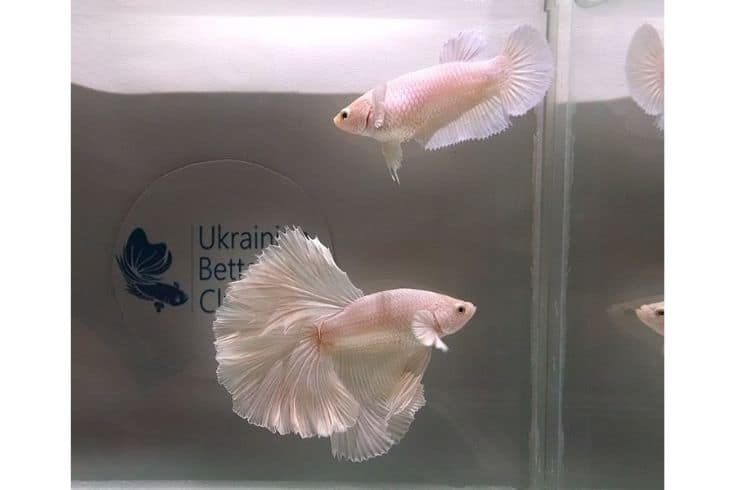
Of course, 3 years is still a relatively short lifespan when compared to other pets such as dogs or cats. This is one of the things you must consider before getting a betta fish. Are you prepared to care for a pet for a short time? If not, you may want to consider another type of pet.
Water Parameter Requirements
Having established that a betta’s quality of life will affect its lifespan, let’s discuss how to provide your fish with the best possible care. Doing so isn’t just about keeping your betta alive – it’s also about keeping your rosetail betta happy and healthy!
Warm, Stable Water Temperature
As we mentioned earlier, Rosetail bettas are native to Southeast Asia. In the wild, these fish live in warm, tropical waters with temperatures ranging from 72-80 degrees Fahrenheit. When keeping these fish in captivity, it’s important to maintain water temperatures within this range.
If the water in your tank is too cold, your fish will become sluggish and may stop eating. In extreme cases, cold water can lead to death. On the other hand, if the water is too hot, your fish will become stressed and may also stop eating. In addition, high water temperatures can lead to the spread of disease.
For these reasons, it’s important to use a reliable aquarium heater to maintain stable water temperatures. This is especially important if your aquarium size is on the smaller side. Small tanks lose heat faster than large ones, so you may need to adjust your heater settings more frequently.
Pristine Water Conditions
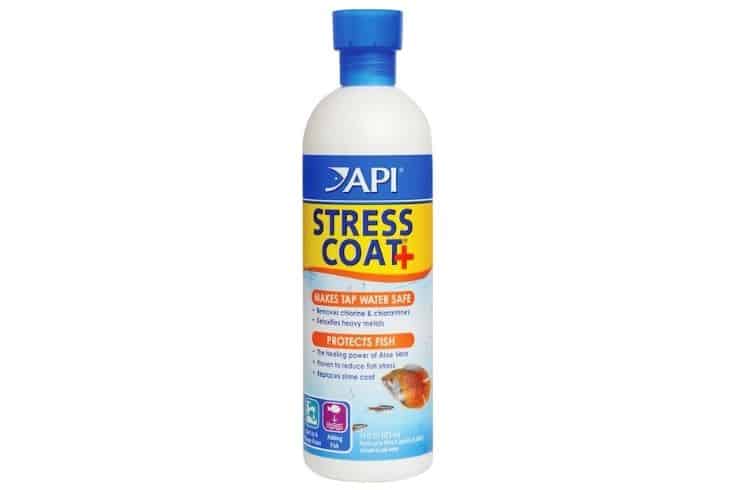
Chemically speaking, clean water refers to water that is free of ammonia, nitrites, and nitrates. Ammonia and nitrites are incredibly toxic to all betta breeds even in small amounts, while nitrates are harmful in high concentrations. For this reason, it’s important to test your water regularly and take steps to keep these levels low.
There are a few different ways you can keep your water clean. The first, and most straightforward way of doing so is to perform lots of water changes. Sounds tedious? That’s because it is. However, water changes are the best way to remove toxins from your tank and they should be done regularly – at least once per week.
Filters are also a great way to keep your water clean. These devices work by circulating water through a series of filters that trap toxins and debris. While filters are great at keeping your water clean, they can also be quite noisy. In addition, some bettas are intimidated by the flow of water created by filters. For these reasons, we recommend using a filter only if your betta seems relaxed in its presence.
Soft Water
In addition to being clean, the water in your tank should also be soft. This is because bettas are native to slow-moving, muddy waters. As a result, they are not accustomed to hard water with high mineral concentrations.
If the water in your tank is too hard, it can cause your fish stress and may even lead to death. For this reason, we recommend using a chemical product, such as the API Water Softener, to soften your water. This product is designed specifically for aquarium use and will not harm your fish.
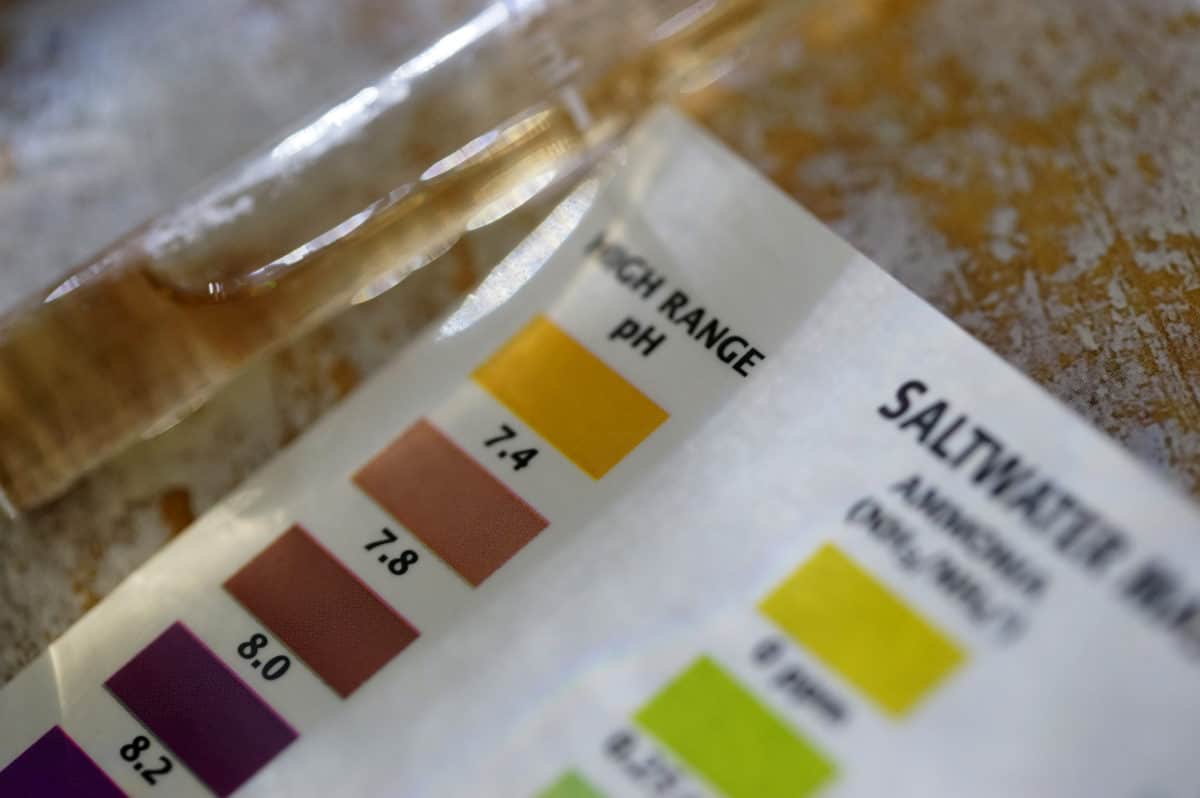
Having said that, we should mention that not all bettas are affected by hard water in the same way. In fact, some bettas seem to do just fine in hard water conditions. If you’re unsure whether your betta falls into this category, we recommend testing the water in your tank before taking any action.
The Right Amount of Water Flow
Unfortunately, rosetail bettas generally have weak swimming ability due to their long fins. As a result, these fish are not well-suited to tanks with high levels of water flow. If the water circulation in your tank is too strong, it can drag your betta’s fins too much, making it difficult for them to swim.
In addition, the direction of water flow can also be a problem for rosetails. If the flow of water is directed towards your betta’s face, it can cause stress and may even lead to death. For this reason, we recommend keeping the water flow in your tank to a minimum and making sure that the filter outflow pipe is pointing away from your fish.
Above all, a flow adjuster will give you much more control over the circulation of water in your tank. This handy little device allows you to change the flow rate of your filter without having to adjust the actual filter settings. As a result, you can keep the water flow in your tank at a level that is comfortable for your betta.
Temperament and Tankmates
It’s only natural to want to keep your beautiful betta fish in a large display tank next to other tank mates. However, this isn’t always the best idea. Bettas are notoriously aggressive towards other fish and will often fight to the death if given the chance. This is part and parcel of natural betta behavior, and it’s something that you need to be aware of before adding any tank mates.
Of course, there are some fish that can coexist peacefully with bettas. These fish are typically those that are too large or too fast for bettas to catch. In addition, these fish usually have a peaceful temperament and are not likely to start fights with other tank mates.
Some examples of fish that can be safely kept with bettas include:
- Gouramis
- Danios
- Barbs
- Rasboras
- Tetras
If you’re unsure whether a particular fish is compatible with bettas, we recommend doing your research before adding it to your tank.
What Do Rosetail Bettas Eat?
Maintaining your rosetail’s beautiful finnage is not only about keeping the water in your tank clean and well-oxygenated. It’s also important to feed your fish a diet that is rich in vitamins and minerals.
In the wild, bettas feed on a variety of small insects and crustaceans. However, these foods are not always readily available to captive bettas. As a result, most betta owners feed their fish a diet of betta pellets or flakes. Many commercially produced betta food will also be formulated with natural color enhancers that bring out the best in your pet’s vibrant colors.
Because bettas are surface feeders, it’s also vital that you choose something that’s slow-sinking. In addition, you should supplement their diets with live food sources such as brine shrimp, bloodworms, and daphnia. Not only are these foods a great source of nutrients, but they will also help to keep your betta’s interest in their food.
Common Health Issues
A good diet can help keep your betta healthy and free from disease. However, bettas will sometimes succumb to illness, regardless of how well they are cared for.
The most common health problems that affect bettas include:
Health Issue
Ich (White Spot Disease)
Symptoms or Causes
Ich is a very common disease that’s caused by an aquatic protozoan parasite.
Fish infected with Ich develop a sprinkling of tiny white spots on their fins, gill covers, and bodies. They also flash against the gravel and other solid objects in the aquarium.
Suggested Action
Raise the water temperature to 82o F for three days. Use an OTC White Spot Disease medication to treat the tank.
Health Issue
Flukes
Symptoms or Causes
Flukes is the term used to describe various types of external fish parasites. These macroparasites can often be seen with the naked eye attached to the fish’s skin or gills.
Suggested Action
Treat the fish tank with an OTC antiparasitic medication.
Health Issue
Fungal infections
Symptoms or Causes
White fluffy growths on the fish’s body, mouth, and head.
Suggested Action
Quarantine infected fish, and treat with an antifungal medication.
Health Issue
Bacterial infections
Symptoms or Causes
Sores and ulcers on the body and head, ragged, bloody fins.
Suggested Action
Treat the tank with OTC antibacterial treatment.
As you can see, there are a number of different health problems that can affect bettas. However, the good news is that most of these problems can be easily treated with a combination of clean water and medication.
If you notice any strange behavior or changes in your betta’s appearance, we recommend taking them to see a veterinarian as soon as possible.
Breeding Your Rosetail Betta
Rosetail bettas were created over generations of selective breeding by betta breeders. As a result, this fish is not found in the wild and can only be bred in captivity. If you’re interested in breeding your pet fish, you should run it by a well-known betta breeding team with the experience and knowledge to help you get started. This will help ensure that your rosetail betta is properly cared for and that you end up with healthy, vibrant fry.
- The first step in breeding your fish is to set up a breeding tank. This tank should be at least 10 gallons in size and should have a sponge filter and an air stone to provide aeration. In addition, the tank should be decorated with plenty of plants and hiding places.
- The next step is choosing a male and female rosetail betta you would like to breed. These fish should be healthy and free from any genetic defects. Betta females are typically smaller than males and have shorter fins. In addition, female bettas often have a duller coloration than males.
- Once you have chosen your breeding pair, you will need to acclimate and place them in the breeding tank. The male will build bubble nests before chasing the female around to get her to release her eggs. The breeding of rosetails continues much in the same way as other bettas.
The fry will hatch after 24-48 hours and should be free swimming after 5-7 days. At this point, you can start feeding them small live foods such as brine shrimp or microworms. Betta fans will be delighted to learn that the fry of this fish grow relatively quickly and will reach maturity within 4-6 months.
Rosetail Betta Fish Tank Requirements
Now that you know a little bit more about this beautiful fish, it’s time to talk about setting up the perfect home for your new pet. Understanding their requirements in a home aquarium is critical to maintaining a healthy and happy betta. Here are some key aspects of an ideal rosetail tank:
Well-Chosen Décor
What’s a home without some furniture? Plants, betta hammocks, and other decorations give your betta a place to explore, play, and hide. These items also help make your aquarium look more attractive. A plain environment, much like an empty apartment, can lead to boredom and depression in your betta.
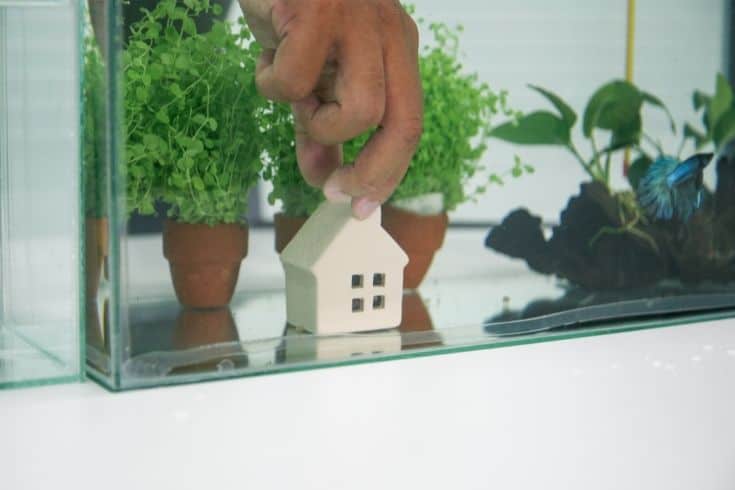
Rosetail betta fins are long, heavy, and delicate, so steering clear of sharp edges is important. Décor such as driftwood and live plants such as water sprite are ideal. You can also opt for a silk plant if plant maintenance is not your thing.
In terms of hideaways, caves and betta logs make perfect little homes for your betta. Be sure to choose a size that is big enough for your betta to comfortably enter and turn around in, but not so large that it becomes a swimming hazard.
Aeration
You may have heard that bettas are labyrinth fish that come to the surface for air, and you would be right! However, this does not mean that they do not need an aerated aquarium.
Bettas require a constant supply of fresh oxygen to stay healthy and active. An air stone or bubbler is a great way to add oxygen to your tank while also providing your betta with some fun bubbles to play in.
Regardless of which aeration method you choose, you can rest assured knowing that you’ve selected a piece of aquarium equipment that will benefit your betta in many ways.
Filtration
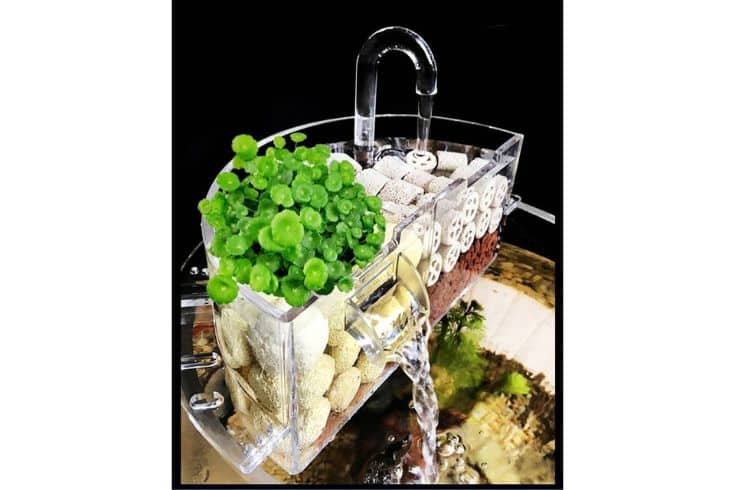
Bettas are not heavy waste producers, but they still need a filter to keep their water clean and free of ammonia and other toxins. A hang-on-back filter or canister filter will work well for a rosetail betta tank.
Just be sure to choose a filter with adjustable flow. Ideally, you want to be able to control the direction of water flow as well as the flow rate. Bettas are not fans of strong currents and can become stressed if the water moves too quickly.
Ample Space
Just because wild bettas live in slow-moving or stagnant waters, does not mean that your captive betta will be happy in a tiny bowl. A minimum tank size of 2.5 gallons is required for a single betta, but a 5 gallon tank is ideal.
The extra swimming space will allow your betta to explore, exercise, and build bubble nests. Plus, a larger tank is much easier to maintain than a smaller one.
When choosing a tank size, be sure to factor in the space that will be taken up by plants, decor, and the filter. A good rule of thumb is choosing a tank at least 20 inches long.
Product Recommendations For Rosetail Betta Tanks
Now that you know what to look for in a rosetail betta tank, it’s time to start shopping! Here are a few products that we recommend for anyone looking to set up a rosetail-friendly aquarium:
- LANDEN Ultra Clear Glass Rimless Low Iron Aquarium Tank – Designed as an all-in-one tank setup for aquarium fish, this kit comes with everything you need to get started, including a glass aquarium, filter, and LED lighting.
- Fluval Bug Bites – A crucial aspect of betta care is knowing how to boost their immune systems with the best diet possible. These pellets are made with black soldier fly larvae and salmon protein, two ingredients that are sure to keep your betta happy and healthy.
- Aqueon QuietFlow LED PRO Aquarium Power Filter – This powerful filter is designed for aquariums up to 100 gallons and comes with three media baskets, a submersible pump, and an LED display that shows you when it’s time to change the filter media.
Setting Up A Rosetail Betta Tank
Now that you know what to look for in a rosetail betta tank, it’s time to start setting up your aquarium! If you are using an all-in-one aquarium kit, follow the instructions that come with your tank. Otherwise, here is a general overview of how to set up a rosetail betta tank:
- Fill your tank with dechlorinated water and install the filter and heater. Let the tank cycle for at least 24 hours before adding any fish.
- You can also add live plants and decor to your tank during this time. Be sure to choose plants that are safe for bettas and do not have any sharp edges.
- Once the tank is cycled, it’s time to add your betta! Gently place them in the tank and allow them to acclimate to their new home. Monitor your pet closely for the first few days to ensure they adjust well.
And that’s it! Now it’s time to sit back and enjoy your beautiful new rosetail betta tank!
The Takeaway
While they may be small, rosetail bettas are feisty fish that require plenty of care and attention. We hope this article has given you the information you need to get started with keeping your own rosetail betta!
Please feel free to leave a comment below if you’ve had first-hand experience with this beautiful fish. And do not forget to share this article with any fellow fish-keepers in your life! Thanks for reading, and as always, happy fish keeping!
